Below is a real “dear laurel letter” from a reader whose pine wood stain color took on a reddish hue after he refurbished the wood with polyurethane.
Dear Laurel,
I thoroughly enjoy your blog and think you give spot-on advice every time; it’s a fun read as well.
Here’s my problem and I don’t know if you can help or not. We just bought a beautiful mid-century home in Irvington, with stunning, pine wood-paneled ceilings.
We added a polyurethane in a satin finish to the wood as it was starting to look rather exhausted.
But now it has a more reddish tone than I prefer a stained pine wood to have. I can live with it, but I am hoping to choose a wall paint color that will minimize the red in the wood stain color.
Do I go warmer on that color? That is, stay closer to the red on the color wheel? Or should it be cooler, like a bluish tone?
My first instinct is to do a deep navy, but I’m thinking maybe that will just make the ceiling wood redder? Now I’m contemplating a warm gray. I’m just so confused, and need to be pointed in the right direction.
Thank you,
Jay
I wish that someone would point me in the right direction too! haha. Not to minimize Jay’s dilemma.
It always makes me feel badly, but I had to tell Jay that I’m not doing consultations and can’t give him advice via email. But I do try to answer everyone and this was my advice.
I am wondering if there’s a way to tone down the red in the wood. That would be first on my list to investigate. Then, I would work with a designer who specializes in color for a color consult.
That beginning line has been percolating in my head. And that’s because getting the color of the stain to be what we want it to be is a crap-shoot at best. And that’s even with samples. It’s not an exact science by any means.
In addition, Jay’s ceiling is pine and that is known to be a difficult wood to deal with. Here is a fabulous article that explains the technique for getting a stain on pine to go on evenly.
But this isn’t going to help Jay or anyone who might want to tweak a wood stain color that turned out too red, ashy, light, orange…
If it’s too dark, you’re out of luck. That one is a do-over.
However, if your color needs correcting and/or darkening there are a few things one can do to fix it and some of them don’t require removal of either the existing poly or stain.
How does that sound?
Well Laurel, what about just keeping it as is and using a wall color that will make the red in the wood less noticeable?
Yes, good question. This is one of my favorite posts about what colors look great with stained wood trim.
And another great post also about stained wood trim.
However, while I think that it’s possible to minimize the red in the wood tone to some extent with a wall color, the red tone may still reflect some into the room. That might not be so good.
You know the old expression, putting good money after bad? It’s often best to fix the thing that’s wrong even if it costs a few dollars to do so.
I realize, though, that it’s a lot easier to try to make what’s there work.
However, I love the idea of creating a new wood stain color without totally having to refinish it, down to the bare wood.
But first, in regards to Jay’s home, 99% of the time, when I think of mid-century modern and a wood ceiling, I think of white walls. In fact, my mom and step-dad built in 1980, a beautiful contemporary home with lofty stained pine-wood ceilings that were similar to the ceiling in the image below.
All of their walls were painted a soft white.

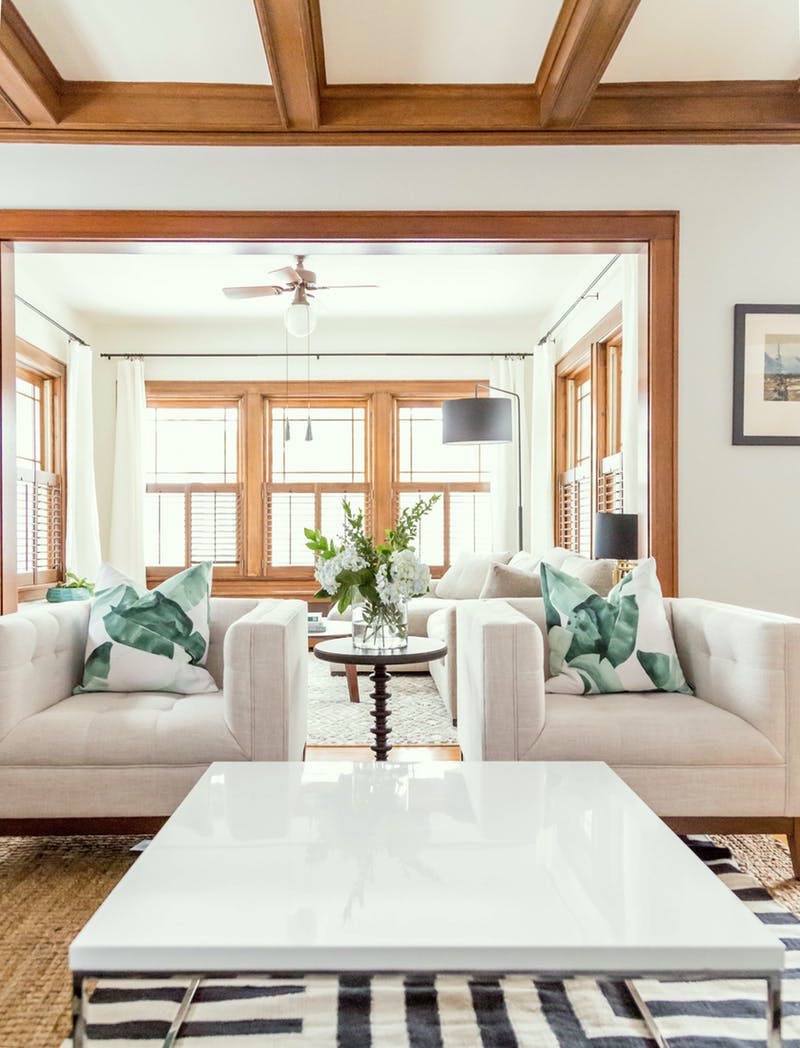
This is actually a 100-year-old home that feels contemporary with its wood stained trim and white walls
Okay, here’s the deal with changing the wood stain color.
And you already know what it is.
The wood is stained AND has a coating that’s intended to seal it (the polyurethane) and make it impervious to being re-stained.
Drat!
If Jay were doing this project from the beginning, I would’ve recommend that he make some samples mimicking as closely as possible with what is there, to see what looks the best.
Same sitch with the impending wall colors. :]
Anything that is used of course, will need to be able to go on top of the existing polyurethane. Well, duh.
Of course, it needs to stay put.
Here’s idea number one to fix the stained wood color.
Apply another coat of poly that’s tinted to minimize the red.
Minwax makes a product that is exactly that, called Polyshades. The name gives it away. It’s polyurethane and stain, all in one product.
Here is a link to a video which shows how Polyshades is done on a chair. I wish that they had used a lighter color, or showed how one coat looks. But it’ll give you an idea.
By the way, Minwax does not recommend using Polyshades on floors, but they do have another product, called One-Step which is for floors. I don’t know what the difference is.
Polyshades comes in a bunch of different colors, but what if none of the colors do what we want it to do? In this case, we want to remove some of the red. And the way to do that is to add a tint of green or maybe a raw umber.
Here is an article that explains how to tint polyurethane. It does require some experimentation.
Here are two brands of universal colorants that one can add to Polyurethane and other finishes to tint them. They each have numerous colors.
One brand is called Chromaflo
Another brand is called Mixol
So, let’s say that your wood is super orange-y. To knock that orange back, I would try a blue or a blue-green. It probably won’t take a lot. It’s a lot like putting a glaze on one’s hair, for those of you who do that. :]
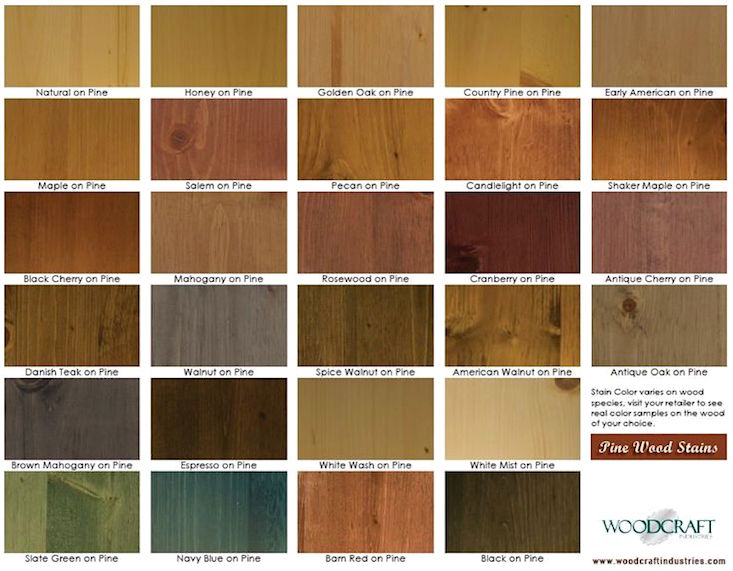
I found this interesting chart and I tried and tried to find the original source. It is not wood craft industries. That website is something entirely different now. But what’s interesting is that these are all stains over pine! I love that a navy stain over pine looks teal!
If you wish to make the wood darker, another product to try is a gel stain.
Gel stains are much thicker than regular stains and easier to work with. They can work by themselves, or they CAN go over an existing polyurethane finish. This is terrific article that discusses how to do this.
A third way to change the color of an existing stained and finished wood surface is with the addition of a tinted paste-wax. This one seems better for a smaller area. You can read about wax over poly here.

Andrew and Rachel Ashmore did a number on this brand new ceiling to make it look old and wonderful in their master bedroom.
A fourth option is to put a tinted glaze over the existing poly. There are oil-based glazes and water-based. The former is phenomenally noxious, so I’d opt for the water-based. The glaze is a medium to which the universal colorant is added.
You will need to make sure that your existing poly is very well-cured before trying this method. And that means waiting about a month.
An excellent post about the best ways to stain pine can be found here.
I even found an article about staining with shoe polish. And you know, I have used shoe polish to create antiquing for small things.
Jay talked about maybe doing a reddish dirty gray color in another email. I think that’s a great color with wood trim.
Below the first image is another photo of a cool antique-looking pine floor that’s more red. I think this dirty purple looks great with both shades of stained wood.
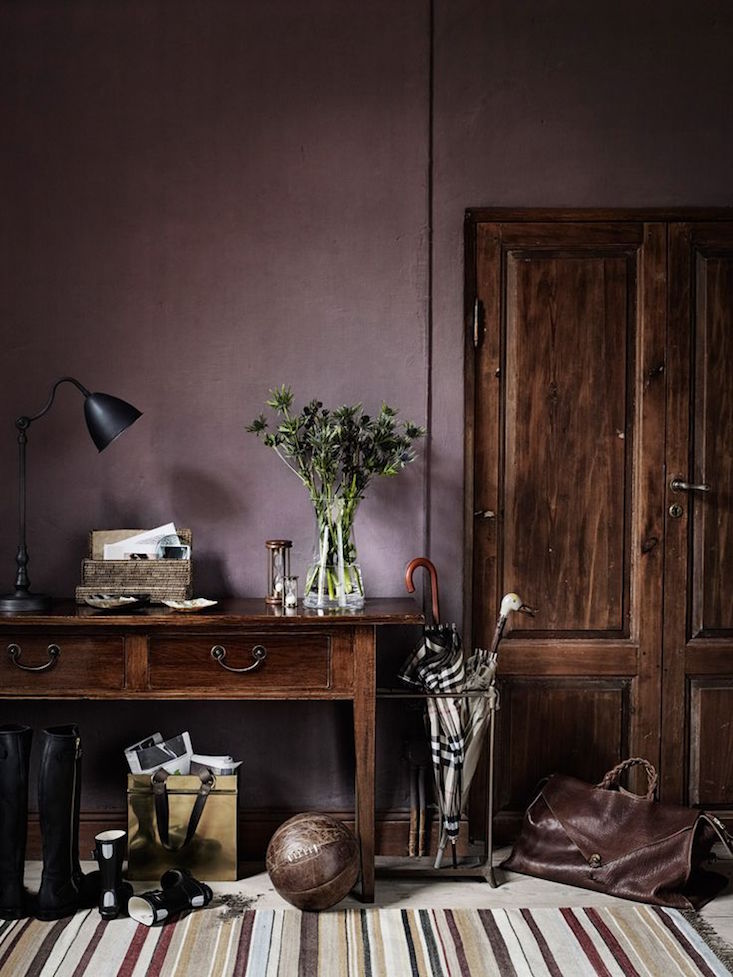
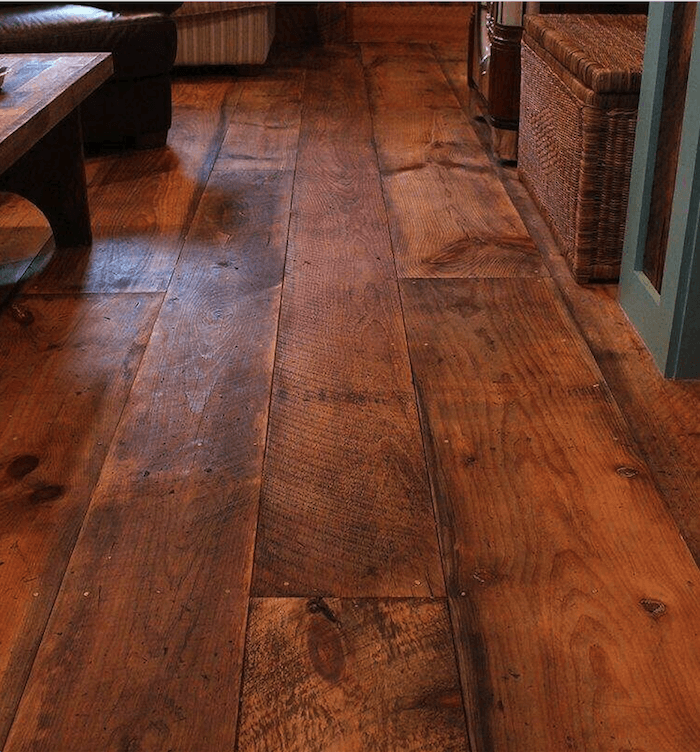
Sorry, sources for the above two images unknown, but speaking of wood stained floors, please check out this post that has much info plus the popular floor cleaner that will wreck them! If you’re more into painted wood floors, please check this post out.
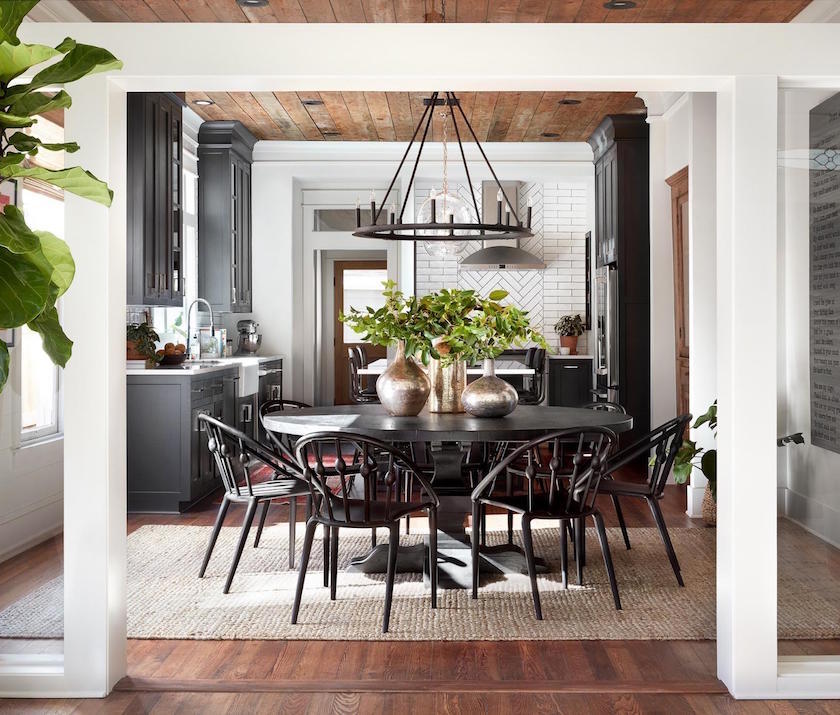
Above and below, a beautiful contemporary home via Magnolia with a gorgeous stained pine ceiling.
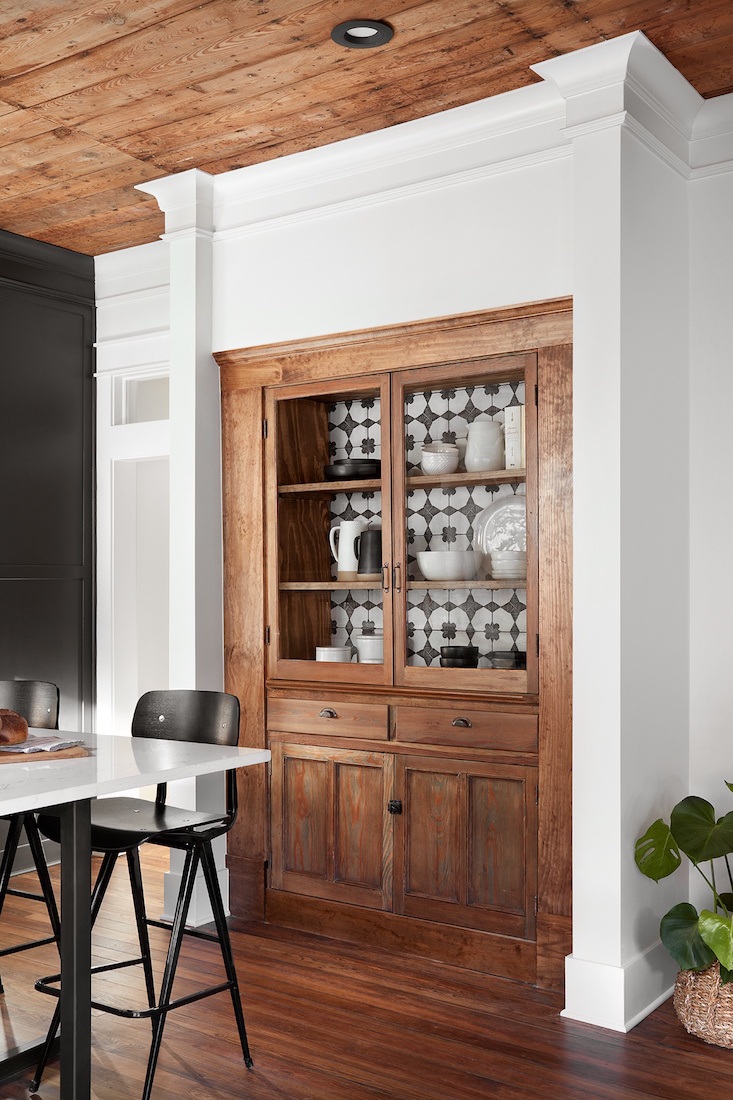
Beautiful built-in cabinet too. And that looks like encaustic cement tiles behind the glass doors.

A Gorgeous lakeside home by Muskoka Living.
I’m not sure what kind of wood that is on the ceiling, but it sure is lovely. You can check out the rest of this amazing home in the link. I adore those slipcovers and the bottom banding.
Well, that was an interesting exercise about the possibility of changing a pre-existing stained wood finish. Has anyone ever done that and what were the results?
xo,

Please don’t forget to check out all of the beautiful hot sales!
Related Posts
 Dated Tuscan Home Transforms With Blue and White Decor
Dated Tuscan Home Transforms With Blue and White Decor Finding Bathroom Storage For A Small Difficult Bathroom
Finding Bathroom Storage For A Small Difficult Bathroom Love Me A Warm Color Scheme But Is It Going To Look Dated?
Love Me A Warm Color Scheme But Is It Going To Look Dated? Beige Decor — How To Make It Go From Boring To Sensational!
Beige Decor — How To Make It Go From Boring To Sensational! Pulling My Hair Out! I Need Five Area Rugs That Coordinate!
Pulling My Hair Out! I Need Five Area Rugs That Coordinate! How To Get The Cool-High-End Bathroom For A Lot Less
How To Get The Cool-High-End Bathroom For A Lot Less Easy Fixes For A Dated Living Room With Huge Potential
Easy Fixes For A Dated Living Room With Huge Potential




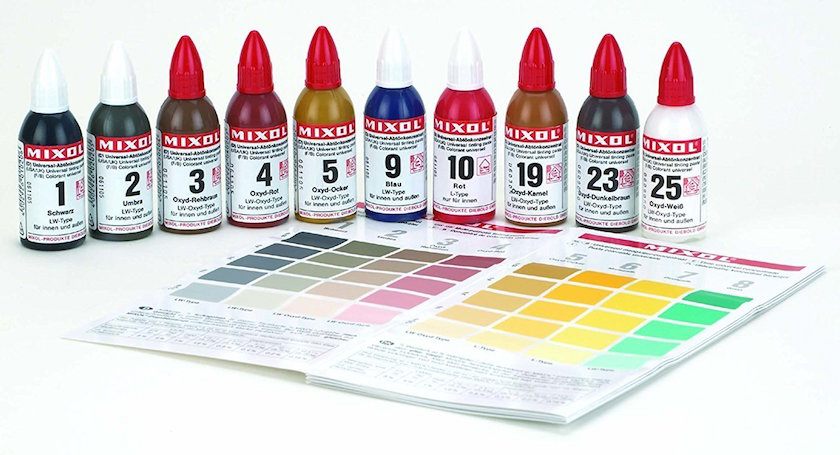



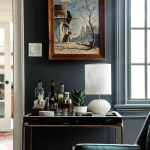


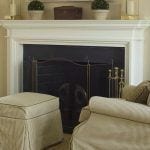







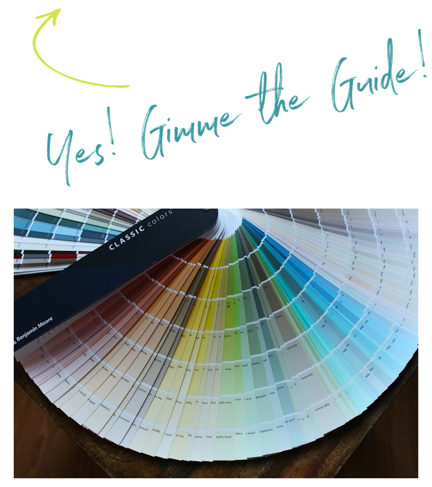
29 Responses
Hi all,
First of all, I love all the positive, helpful comments! So refreshing to see! We are staining the interior of our log home, and I’m kinda freaking out over how to tweak the color. The easier, the better, since it’s a LOT of surface area. The logs are white pine, and we used an oil based one coat stain and finish. It’s sooo red looking. We tested it on a log first, but realized that it was a log without much grain showing. With the wood grain on the actual walls, it turned out much darker and redder than expected. Now I feel overwhelmed at trying to color coordinate the whole rest of the house… Paint, furniture, kitchen cabinets… We have been working on building our home while living in our camper with our 2 teenage boys for the past 16 months- (6 of those months with snow on the ground!) It’s been a long, hard process, so seeing our stain not turn out as expected is causing tons of stress after everything we’ve poured into building our home. Any advice would be so greatly appreciated.
I know everyone wants a quick fix, but there is another option. I’ve been stripping antique doors with Citristrip. One application removes up to 7 layers of paint (so far), but the real magic is when the paint is all off. And that only takes a couple of hours and no space suit. Another application of Citristrip has sucked the old stain right out of the wood, so I’ve got these 100 year old doors in raw wood. No sanding, no scraping, just a scrubbie and water.
So although it would take a couple hours, because you MUST leave it alone, this could possible work for removing the poly and stain, so Jay could start over.
Just another idea.
Thanks for sharing that info Christine. That sounds like a great possibility.
Laurel, Though no longer proffering advice by email, I’m so relieved that you so kind-heartedly provided guidance for Jay’s dilemma. I can only imagine he and others with the same problem jumped for joy to be pointed in the right direction(s). You gave them hope. That’s a good thing!
Hi Gloria,
I wish I could give advice. Some days, it’s everything I can manage just to read the emails!
Of course it is, Laurel. Never you mind, everyone of of “us” gets it, accepts it, understands it! Thanks for all the goodies you share despite any obstacles of your day. Believe me when I say, “we” repay you with much goodwill directed your way. (Don’t take time to reply, just wanted to reassure you).
I used polyshades on my steps. I used a dark brown/black polyshade over dark paint and it worked wonderfully…like a miracle. I found the idea on the blog for younghouselove. I think they did the railing in the stairs (in their hallway). They probably have their own dos/don’t and a tutorial or something. Good luck to this person! I once did the same thing to a dining table that I painstakingly sanded. And in the end, I ended up painting over the reddish stain with a faux wood treatment. I think we all learn the hard way at least once with stain!
I think that goes for paint too! Thanks for sharing your experience. The steps sound gorgeous!
Kristi, from the blog “Addicted to Decorating” actually did what you recommended, Laurel–she used a colored polyurethene to tweak and even out the color of her hardwood floors that she had recently refinished herself. I believe that she actually added stain right to the regular poly. I’m not sure if I can add a link, but here it is, from her January 31, 2017 post:
https://www.addicted2decorating.com/the-hardwood-floor-refinishing-adventure-continues-tip-for-getting-a-gorgeous-finish.html
Hi Phyllis,
I love Kristi’s blog and have linked to her a few times on blog posts. Thanks for sharing her beautiful work.
Thanks soooo much for the wood flooring cleaner recipe. I learn something every time I click on your site.
That is one big job working on a wood ceiling. Best of luck Jay!!
Personally, I love white/grey/bleached floors. In my old age, I have become allergic to brown. This is really funny because I would not wear black when I was very young. It seemed too stark to me. My mother made me the most sexy evening dress in dark brown as it was essentially a little black dress style.
Now I cannot stand brown. Used to love navy at that same time. Do not want navy or even blue jeans. All my jeans are black. My coats are mainly black although I do want a winter white coat in the worst way. Black and grey tweed are my favorite blazers at this point.
On the other hand, my favorite bedroom color is still a blue violet since I was 13 or so. I’ve only had the opportunity for that color a couple of times, but everyone who sees it in my house now compliments me on it.
After 30+ years of rentals in white or whatever strange color, I only want what I want.
Laurel, have you or any other readers experienced changing favorite colors and/or developed aversions like mine? I have no clue why my color sense has changed relating to brown and navy.
I want white/grey/bluish grey wood with silver rubbed into them. I love your Gustavian choices Laurel because the wood is not brown.
Call me color crazy.
Hi Ramona,
haha. Not crazy at all! Tastes do often change over time. Sometimes it’s a matter of not being exposed to a style, but once we are, we fall in love.
Twenty plus years ago, I stripped (a nightmare) the dark walnut 70s finish from my kitchen cabinets and redid them all in Polyshades. They still look good today. These are the style of cabinets and drawers that have no knobs or handles, so there are scratches on the top edges of the drawers. Other than that, they look great.
I mixed a couple of colors to get the shade I wanted. The main problem I had in using it was that I’d brush it on, everything would look great, I’d turn my back, and when I looked again, a big drip would be running down the surface. I was able to brush them out successfully.
I don’t know how much the product’s formula has changed since I used it.
Hi Maureen,
I’m not sure if the product has changed or not. But great that it held up well for you. When we painted our cabinets years ago, they were also the kind with no knobs, but in retrospect, I wish that we had put them on because the paint did chip with the constant clutch of the bottom “handle.”
Hi Laurel,
I’ve told you this before, I love the insightful designing tips you offer, but also love and appreciate your sense of humor! Keep it coming!
Blessings
Kristin,
Thanks so much Kristin!
I have used equal amounts of clear glaze and paint to doctor up woodwork. Paint has been used in the past as a toner.
Gray glaze knocks the red down and warms up the color I used purple paint mixed with glaze to give depth and richness to walnut.
Hi Mary Ann,
Thanks so much for sharing your techniques. Sounds Wonderful!
I feel for Jay. Polyshades is known to be notoriously difficult to apply. I suggest searching for “problems with polyshades“ or something similar. There are numerous posts on woodworking forums about it. I had a huge problem trying to stain pine picture frames with Polyshades and ended up thinning it with quite a bit of the appropriate solvent to make it workable. Good luck, Jay!
Hi Marsha,
Oh funny. Shannon that I just answered had a great experience with it and your was not. I did buy a little can of it once many years ago just to see what it was all about. I’m wondering if it’s better to go over a light stain? Or maybe it was the wood. I’m wondering if your frames were already stained or if it was raw wood. Apparently, pine needs to have some steps taken before it’ll take stain, if not already stained. But good that you could make it work.
It was raw wood. I’ve used pre-stain conditioner on other projects on raw wood, but may not have on this project, so maybe that was the difference. It didn’t absorb evenly or flow on evenly. It might work better on already stained wood. Let us know what Jay does to fix this problem!
I used Expresso Minwax Polyshades over a very large tv oak tv stand that was stained cherry. It was very, very red and light to boot. It turned out beautifully!! I highly recommend the product. Easy to work with and great results.
Oh, that’s cool Shannon. Sounds like it was rather pink before you got your hands on it.
Hi Laurel,
I feel for Jay. Great advice you have presented. I refinish furniture and doors for a lot of my clients and Jay needed to test that finish first. Every wood takes stain differently so a tester of substantial size needs to always be done first. Pine in particular takes stain very unevenly so it is essential to apply a pre-wood conditioner prior to staining. (it does not look like he did that) There is a reason pine furniture/flooring gets sprayed in factory. I recently stained a lovely pine floor in one of the original houses in Ottawa to match her existing floor. I did a whole lot of testing first but it looks beautiful. I do not recommend water based stains as they tend to come out blotchy (unless you are spraying them). I don’t think the gel stain would adhere the the polyurethane – at least not adequately but Jay can test it. What hecould do though is to test applying a glaze (not directly on the ceiling but a similar scrap piece of pine that he has stained and polyurethaned the same as his ceiling (make a bunch of them for testers) and see how it works out. I also use fiddes and sons rugger brown wax on a lot of the furniture I restore and its lovely for toning down a colour. You need to wear a chemical mask when you apply this though as it smells (lee valley tools has them) and you need to get a good buffing brush that can be attached to your drill as it will need to be buffed a lot. Waxing is a ton of work even with a buffer so if your ceiling is large, you may want to steer away from this option. It does give a beautiful satin patina though.
As to colours, definitely find yourself a good decorator who can give you some options. Go out and buy sample cans and paint some press-wood panel boards and then see what the colours are like daytime/nighttime with lights/ all walls. But fix your ceiling first. You could always paint it. I have painted a lot of pine panelling and it looks beautiful but make sure you shellac the knots first.
Hi Margaret,
Thanks for all of your great advice!
Not as experienced as Margaret, however with what I have learned vie trial and error I agree with what she has stated. Pine definitely must be pre-conditioned to take on an even stain and even then IMO it is no guaranty that it will. That said; my go to choice is ‘gel’ for smaller projects whereas I have used boiled linseed oil on natural/raw pine both for a entire ceiling and in another space for ceiling beams which at first gives you a close resemblance to the maple finish as shown in the Woodcraft Sample Chart BUT …. will darken overtime with age. As an example to achieve an exact match; when adding a ‘new’ mantle in Pine in the latter space where I opted again to use the oil, I had to ‘lightly’ go over it with a stain however for the life of me cannot recall what colour or product I used but do remember wiping the excess off blending it to my liking. So that is another tip for those considering such a project however, I would not recommend it for floors. As for Jay’s dilemma, I do hope he can find a solution. -Brenda-
*Footnote: The linseed oil is applied with a rag and being an oil gives you a soft sheen with a warm glow as it is penetrated into the wood.
Hi Brenda,
Thanks so much for your terrific input!
There are more outside links to info in this post than usual and there’s a link talks about preparing the pine and I found it in numerous places. I figured that people will click on the topics of interest. It says exactly what you guys are saying about the pine. But, it’s an important point, that I should’ve brought up in the post.
Fantastic info, Laurel. So useful to know. I have unsealed floors (original & old) in various states. Will refinish someday. Many other priorities.
Thanks Libby and I hear you on the other priorities part!